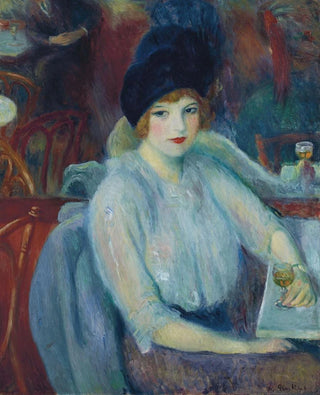Art print | Café Lafayette Portrait by Kay Laurell - William James Glackens


View from behind

Frame (optional)
In the fascinating world of art, some works transcend the simple frame to become witnesses of their era. "Café Lafayette Portrait de Kay Laurell" by William James Glackens is one of these creations. This painting, vibrant with life and colors, captures not only the essence of a particular moment but also the personality of its model, Kay Laurell. The scene, imbued with a Parisian atmosphere, invites the viewer to immerse themselves in a universe where elegance and modernity meet. Contemplating this piece, one feels an intimate connection with the social life of the early 20th century, a time when cafés were places of gathering and exchange of ideas.
Style and uniqueness of the work
Glackens' style, marked by impressionism and post-impressionism, stands out for its bold use of color and light. In "Café Lafayette Portrait de Kay Laurell," warm hues and dynamic brushstrokes create a lively and joyful atmosphere. The artwork is a celebration of modernity, where the artist manages to capture the movement and energy of lively places. The composition, centered on Kay Laurell's expressive face, highlights not only her beauty but also her character. The careful details, such as the play of light on her face and the texture of her clothing, reveal Glackens' technical mastery. This piece is an invitation to observe, to feel, and to immerse oneself in the vibrant world of the Belle Époque.
The artist and his influence
William James Glackens, an emblematic figure of the American impressionism movement, successfully combined tradition and modernity throughout his career. His work, spanning several decades, reflects a deep commitment to everyday life and urban scenes. Glackens was influenced by his European contemporaries, but he also developed a unique style that is his own. By painting portraits, scenes of daily life, and landscapes, he contributed to redefining the perception of American art in the early 20th century. His approach, blending realism and idealization, opened

Matte finish

View from behind

Frame (optional)
In the fascinating world of art, some works transcend the simple frame to become witnesses of their era. "Café Lafayette Portrait de Kay Laurell" by William James Glackens is one of these creations. This painting, vibrant with life and colors, captures not only the essence of a particular moment but also the personality of its model, Kay Laurell. The scene, imbued with a Parisian atmosphere, invites the viewer to immerse themselves in a universe where elegance and modernity meet. Contemplating this piece, one feels an intimate connection with the social life of the early 20th century, a time when cafés were places of gathering and exchange of ideas.
Style and uniqueness of the work
Glackens' style, marked by impressionism and post-impressionism, stands out for its bold use of color and light. In "Café Lafayette Portrait de Kay Laurell," warm hues and dynamic brushstrokes create a lively and joyful atmosphere. The artwork is a celebration of modernity, where the artist manages to capture the movement and energy of lively places. The composition, centered on Kay Laurell's expressive face, highlights not only her beauty but also her character. The careful details, such as the play of light on her face and the texture of her clothing, reveal Glackens' technical mastery. This piece is an invitation to observe, to feel, and to immerse oneself in the vibrant world of the Belle Époque.
The artist and his influence
William James Glackens, an emblematic figure of the American impressionism movement, successfully combined tradition and modernity throughout his career. His work, spanning several decades, reflects a deep commitment to everyday life and urban scenes. Glackens was influenced by his European contemporaries, but he also developed a unique style that is his own. By painting portraits, scenes of daily life, and landscapes, he contributed to redefining the perception of American art in the early 20th century. His approach, blending realism and idealization, opened






